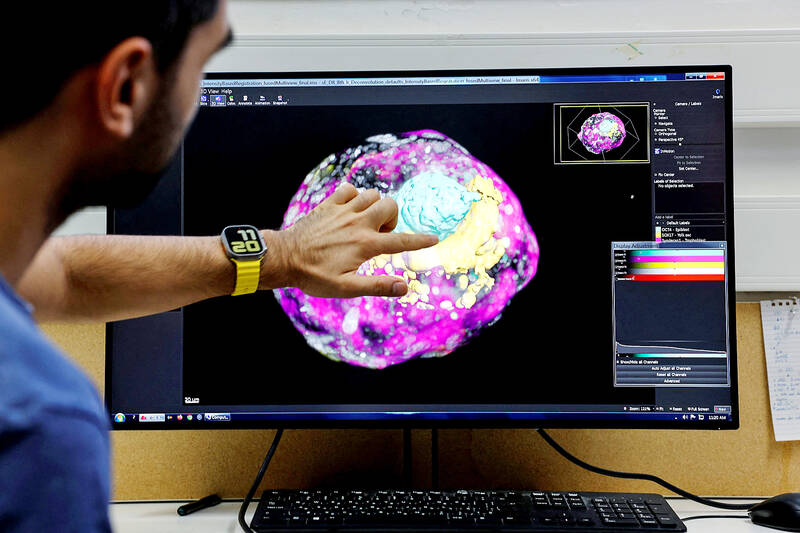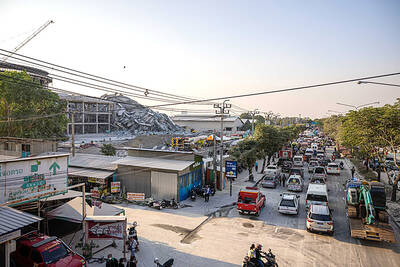Scientists have developed human embryo-like structures without using sperm, an ovum or fertilization, offering hope for research on miscarriage and birth defects, but also raising fresh ethical concerns.
Earlier this year, several labs around the world released pre-print studies, meaning they had not been peer-reviewed, describing their development of early human embryo-like structures.
However, one group’s research has now been published in the peer-reviewed journal Nature, describing how researchers coaxed human embryonic stem cells to self-organize into a model resembling an early embryo.

Photo: AFP
The research was welcomed by some scientists as an “impressive” advance that could help unlock secrets about the precarious early stages of pregnancies, when failure is most common.
However, the work is likely to renew debate on the need for clearer ethical rules on development of lab-grown human embryo models.
The researchers, led by Palestinian scientist Jacob Hanna at the Weizmann Institute in Israel, harnessed the power of embryonic stem cells, which can become any kind of cell.

Photo: Reuters
They produced embryo models up to 14 days old, which is the legal limit for human embryo lab research in many countries, and the point at which organs like the brain begin to develop.
The researchers said their work differs from those of other teams, because it uses chemically rather than genetically modified embryonic stem cells and produces models more like real human embryos, complete with yolk sac and amniotic cavity.
These similarities could make the models more useful for research into conditions such as miscarriage, birth defects and infertility, said James Briscoe of Britain’s Francis Crick Institute.
The model “seems to produce all of the different types of cells that form tissues at this early stage of development,” said Briscoe, principal group leader and associate research director at the biomedical research charity.
The research “is a step towards opening a window on the period of human development, where many pregnancies fail and which has been really difficult to study up until now,” he said.
Both the researchers and scientists not involved in the work said that the models should not be considered human embryos.
The structure “highly resembles, but [is] not identical, to the in utero situation,” the research says.
The success rate on generating the models was also low, with the stem cells organizing correctly just a small percentage of the time.
Still, “in contrast to similar studies published earlier this year, these embryo-like structures contained most of the cell types found in developing embryos,” said Darius Widera, an expert in stem cell biology at the University of Reading in England.
The research and other recent work show “that models of human embryos are getting more sophisticated and closer to events that occur during normal development.”
That highlights “that a robust regulatory framework is more needed than ever before,” he added.
In Britain, Cambridge University has begun developing the kingdom’s first governance framework for stem cell-based human embryo models.
British law prohibits the culturing of human embryos in labs beyond the 14-day mark, but because the structures derived from stem cells are formed artificially, they are not explicitly covered by existing regulations.
Still, most researchers have adopted voluntary limits on their work at this stage.
The Weizmann Institute research did not develop its models beyond 14 days and does not involve transferring the models into a human or animal womb.

AIR SUPPORT: The Ministry of National Defense thanked the US for the delivery, adding that it was an indicator of the White House’s commitment to the Taiwan Relations Act Deputy Minister of National Defense Po Horng-huei (柏鴻輝) and Representative to the US Alexander Yui on Friday attended a delivery ceremony for the first of Taiwan’s long-awaited 66 F-16C/D Block 70 jets at a Lockheed Martin Corp factory in Greenville, South Carolina. “We are so proud to be the global home of the F-16 and to support Taiwan’s air defense capabilities,” US Representative William Timmons wrote on X, alongside a photograph of Taiwanese and US officials at the event. The F-16C/D Block 70 jets Taiwan ordered have the same capabilities as aircraft that had been upgraded to F-16Vs. The batch of Lockheed Martin

GRIDLOCK: The National Fire Agency’s Special Search and Rescue team is on standby to travel to the countries to help out with the rescue effort A powerful earthquake rocked Myanmar and neighboring Thailand yesterday, killing at least three people in Bangkok and burying dozens when a high-rise building under construction collapsed. Footage shared on social media from Myanmar’s second-largest city showed widespread destruction, raising fears that many were trapped under the rubble or killed. The magnitude 7.7 earthquake, with an epicenter near Mandalay in Myanmar, struck at midday and was followed by a strong magnitude 6.4 aftershock. The extent of death, injury and destruction — especially in Myanmar, which is embroiled in a civil war and where information is tightly controlled at the best of times —

China's military today said it began joint army, navy and rocket force exercises around Taiwan to "serve as a stern warning and powerful deterrent against Taiwanese independence," calling President William Lai (賴清德) a "parasite." The exercises come after Lai called Beijing a "foreign hostile force" last month. More than 10 Chinese military ships approached close to Taiwan's 24 nautical mile (44.4km) contiguous zone this morning and Taiwan sent its own warships to respond, two senior Taiwanese officials said. Taiwan has not yet detected any live fire by the Chinese military so far, one of the officials said. The drills took place after US Secretary

THUGGISH BEHAVIOR: Encouraging people to report independence supporters is another intimidation tactic that threatens cross-strait peace, the state department said China setting up an online system for reporting “Taiwanese independence” advocates is an “irresponsible and reprehensible” act, a US government spokesperson said on Friday. “China’s call for private individuals to report on alleged ‘persecution or suppression’ by supposed ‘Taiwan independence henchmen and accomplices’ is irresponsible and reprehensible,” an unnamed US Department of State spokesperson told the Central News Agency in an e-mail. The move is part of Beijing’s “intimidation campaign” against Taiwan and its supporters, and is “threatening free speech around the world, destabilizing the Indo-Pacific region, and deliberately eroding the cross-strait status quo,” the spokesperson said. The Chinese Communist Party’s “threats